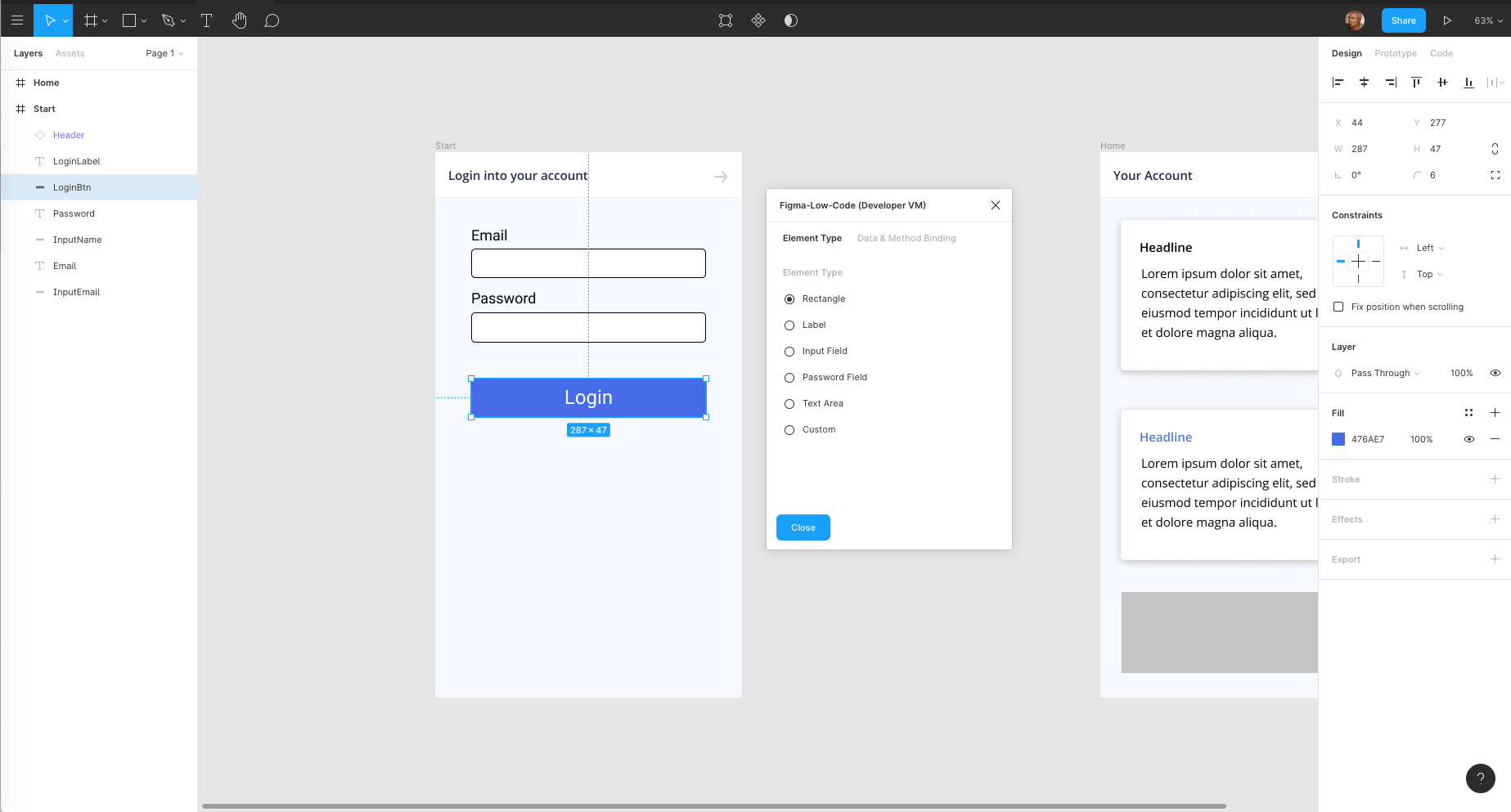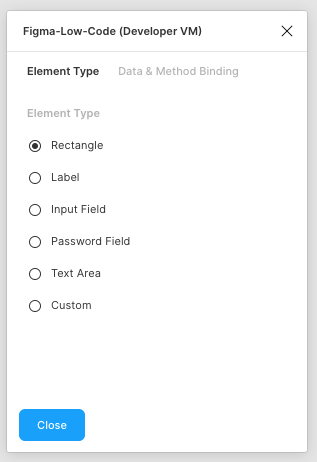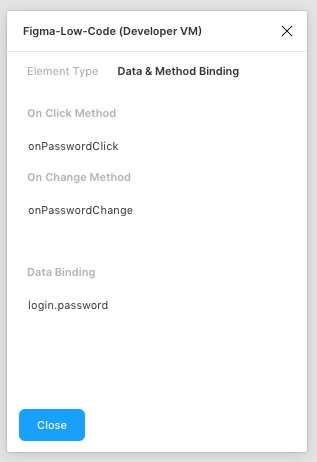Fimga-Low-Code
The Figma-Low-Code package provides a new approach to the hand-off problem (See details below). The core of the solution is the Figma component, which renders the visual design and allows the developers to focus on business logic, without restricting the developers' freedom. The component enables:
- Zero Code rendering of visual design.
- Design changes do not require code changes
- Clear separation of UI and business logic
- Developers can focus on code
- Developers can use the tools and frameworks of their choice.
- Designers stick with their favorite tool
- Easy extension with custom callback functions
- Full support of VUE data binding.
- Extension with custom components
- Extension with custom CSS
- Rich library of stylable components.
Plugin:
You can find the plugin here
Workflow
Figma-Low-Code enables the following workflow to facilitate painless collaboration between designers and developers:
- The designer creates an initial design in Figma
- The developer adds data binding and method callbacks in Figma using the UX Figma-Low-Code plugin.
- The developer sets up a new project (Vue.js for now) and includes the Figma component
- The developer links to the Figma design and creates the required methods and fills them with business logic.
- The Figma component renders the design and invokes the callbacks in clicks.
- Changes in the design are transparent to the developer, he just reloads the design from Figma.
- For deployment the developer downlaods the figma file to freeze the design
How to use Figma-low-code
The easiest way to use Figma-Low-Code is to clone this repository and install Node.js version 12 or higher.
git clone https://github.com/KlausSchaefers/figma-low-code.git
Afterwards, load all dependecies with the following command
npm install
Finally start the server
npm run serve
Once done, open the 'src/views/Home.vue' and enter your figma file id and the access code. You can get the access code in your Figma settings (Details). The file id is the second last url parameter
https://www.figma.com/file/<FigmaFileId>/...
Once you have entered the values, the Home.vue should look like:
<template>
<div class="home">
<Figma :figma="figmaConfig" v-model="viewModel"/>
</div>
</template>
<script>
import Vue from "vue";
import Figma from 'vue-low-code'
Vue.use(Figma);
export default {
name: 'Home',
data: function () {
return {
figmaConfig: {
figmaFile: '<The figme file id here>',
figmaAccessKey: '<Your Figma access key ONLY for development>',
},
viewModel: {
}
}
},
components: {
},
methods: {
}
}
</script>
Figma Plugin
To use the advanced features such as data, method binding or input widgets, you must install the Figma-Low-Code plugin.
Input Elements
By default Figma-Low-Code renders all elements of the design as div, span and label elements. Often this is not enough, and you would like to allow the user to enter to. You can override the default rendering by specifying the desired element type, for instance text fields or password fields. To do so, you need to launch the Figma-Low-Code plugin and select an element. Once an element is selected, you can select from a list of widgets the desired element type.
Data Binding
Figma-Low-Code supports VUE data binding. You have to pass a v-model to the Figma component.
<Figma :figma="figmaFile" v-model="viewModel"/>
You can specify the databinding with the help of the Figma-Low-Code plugin:
- Simply launch the plugin
- Select the desired element.
- Select the 'Data & Mathod Binding tab.'
- Specify the name of the varibale, for instance 'user.name'.
During runtime, the low-code component will update the viewModel and add the values entered by the user, e.g.
viewModel: {
user: {
name: "Klaus"
}
}
Method Binding
In the Figma-Low-Code plugin you can define javascript callbacks for the elements. You can specify the databinding with the help of the Figma-Low-Code plugin:
- Simply launch the plugin
- Select the desired element.
- Select the 'Data & Mathod Binding tab.'
- Enter the name of the method taht should be called on the event (click or change are supported for now)
During run time, the figma component will look for a method with the given name in the parent component (in the example Home.vue). If the method exists, it will be called. The method will have the following signature:
myMethod (value, element, e) {
...
return 'Screen2'
}
If a method return a String matching a screen name, the page will be loaded. In the example the screen with the name 'Screen2'.
Custom components
If the provided input elements are not enough, you can also hook in your own VUE components. To do so:
- Simply launch the plugin
- Select the desired element.
- Select the 'Element Type' tab
- Select Custom
- Enter the name of the component
Furthermore you will need to register the component with the Figma component.
<template>
<div class="home">
<Figma :figma="figmaConfig" v-model="viewModel" :config="config"/>
</div>
</template>
<script>
import Vue from "vue";
import Figma from 'vue-low-code'
import MyComponent from './MyCompenet.vue
Vue.use(Figma);
export default {
name: 'Home',
data: function () {
return {
figmaConfig: {
figmaFile: '<The figme file id here>',
figmaAccessKey: '<Your Figma access key ONLY for development>',
},
viewModel: {
},
config: {
components: {
'MyComponent': MyComponent
}
}
}
},
components: {
},
methods: {
}
}
</script>
Deployment
Working with the file and access key is great for testing and development, because changes in Figma are visible after a reload. However, for production you should NEVER use the access token, as it gives access to all your projects. You can download all files into the project by calling the download script.
node download.js <access_token> <figma_file_id>
The script will download the figma file and all images. You have to point the Figma Component now to the file, instead of the config object. Use an import statement to simply load the JSON.
...
<Figma :figma="figmaFile" v-model="viewModel"/>
...
import FigmaFile from './app.json'
export default {
name: 'Home',
data: function () {
return {
figmaFile: FigmaFile
...
}
},
...
Configure figma-low-code
You can configure certain parameters, e.g. the routing rules. To do so, pass a config object to the Figma component.
<Figma :figma="figmaFile":config="config"/>
The config object can have the following properties and hsould be defined in the data section of the home component.
config: {
css: {
grid: true, // Use CSS grid to align objects. False will use CSS-Flex.
justifyContentInWrapper: true // In justifz or left align content in wrapped elements
},
router: {
key: 'id', // alternative routing parameter
prefix: 'figma' // path prefix that will be used when rendering links
}
}
Custom components and rendering
Sometimes you want to render a certain part of the UI by your self, or replace existing widgets with custom implementations. You can do this by passing a components array to the configuration. These components will be used at the specified screen location instead of the default Figma component. This approach allows you to fully manage certain parts of the UI. Data is passed as a value property and follows default VUE practices.
<Figma :app="app" :config="config"/>
...
import MyWidget from 'src/myWidget'
...
config = {
components: [
{
cssSelector: ".ArtBoard .ElementName",
type: "MyWidget",
component: MyWidget
}
]
}
You specify the widget to be replaced by the custom widget by a css selector. For instance if you want to replace the widget with the name "Custom" on the "StartScreen" artboard, use the ".StartScreen .Custom" selector.
MDI Icons
If you are using the Quant-UX icons components, you have to install the mdi-font package.
npm install @mdi/font
Afterwards import the icons in the App.vue
import '@mdi/font/css/materialdesignicons.css'
The handoff problem
Designers and developers use different tools to build user interfaces. Once a designer has completed the interface design, he hands-off the design to the developer, usually in the form of an image and some specs. The developer has now to rebuild the entire design using the programming language of his choice. Although this process is proven, it is rather slow and not very efficient. In particular later changes in the design makes it hard to automize this work through code generation tools.
Credits
Figma-Low-Code is based on vue-low-code developed by Quant-UX.



